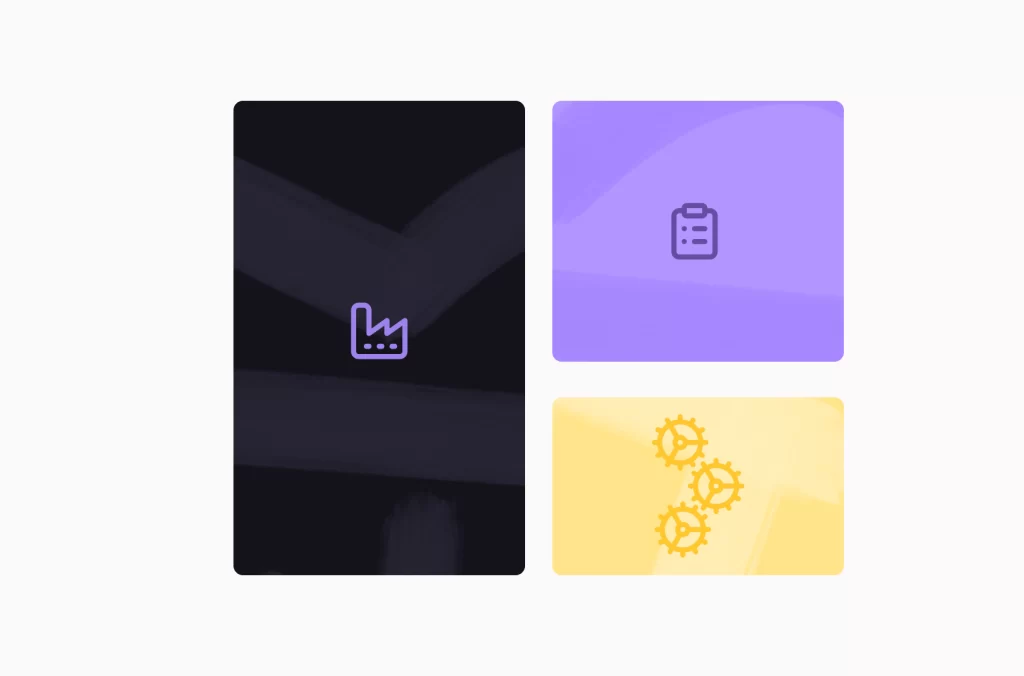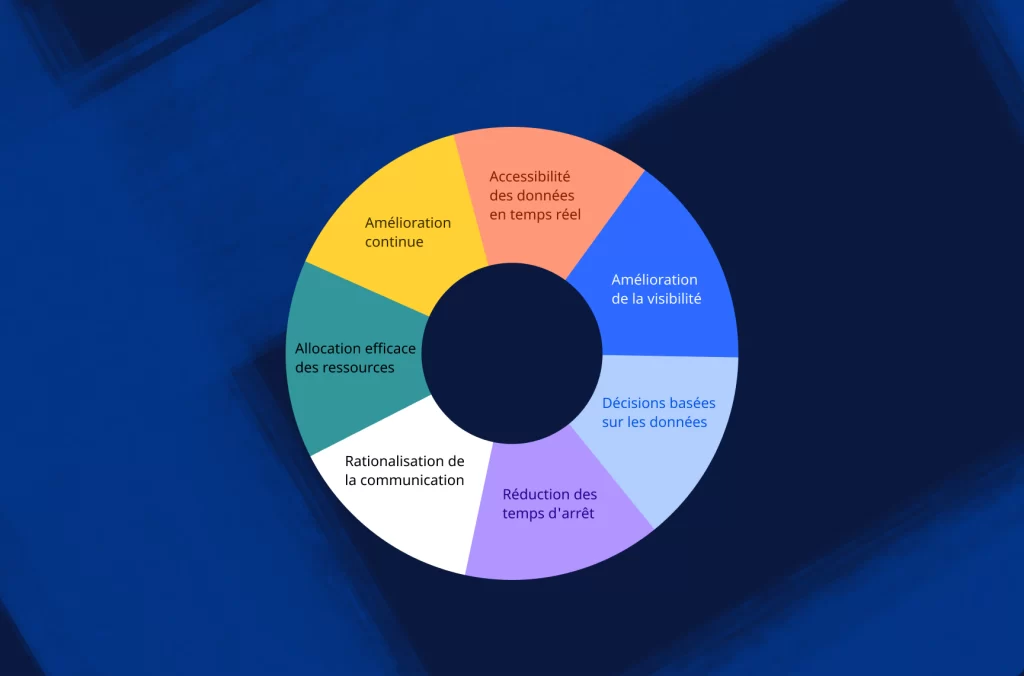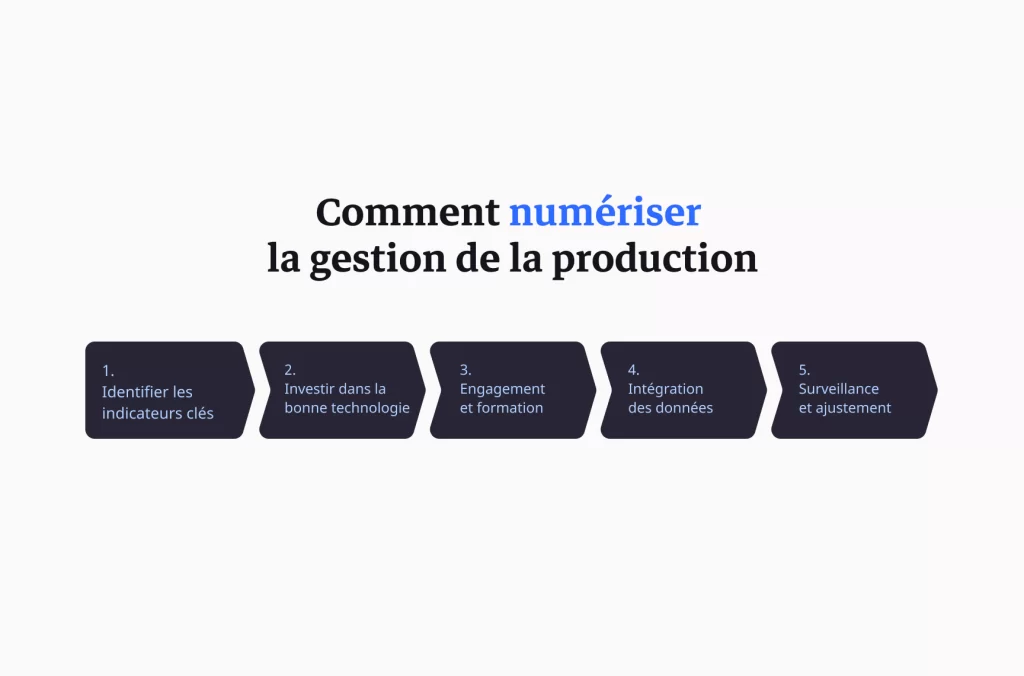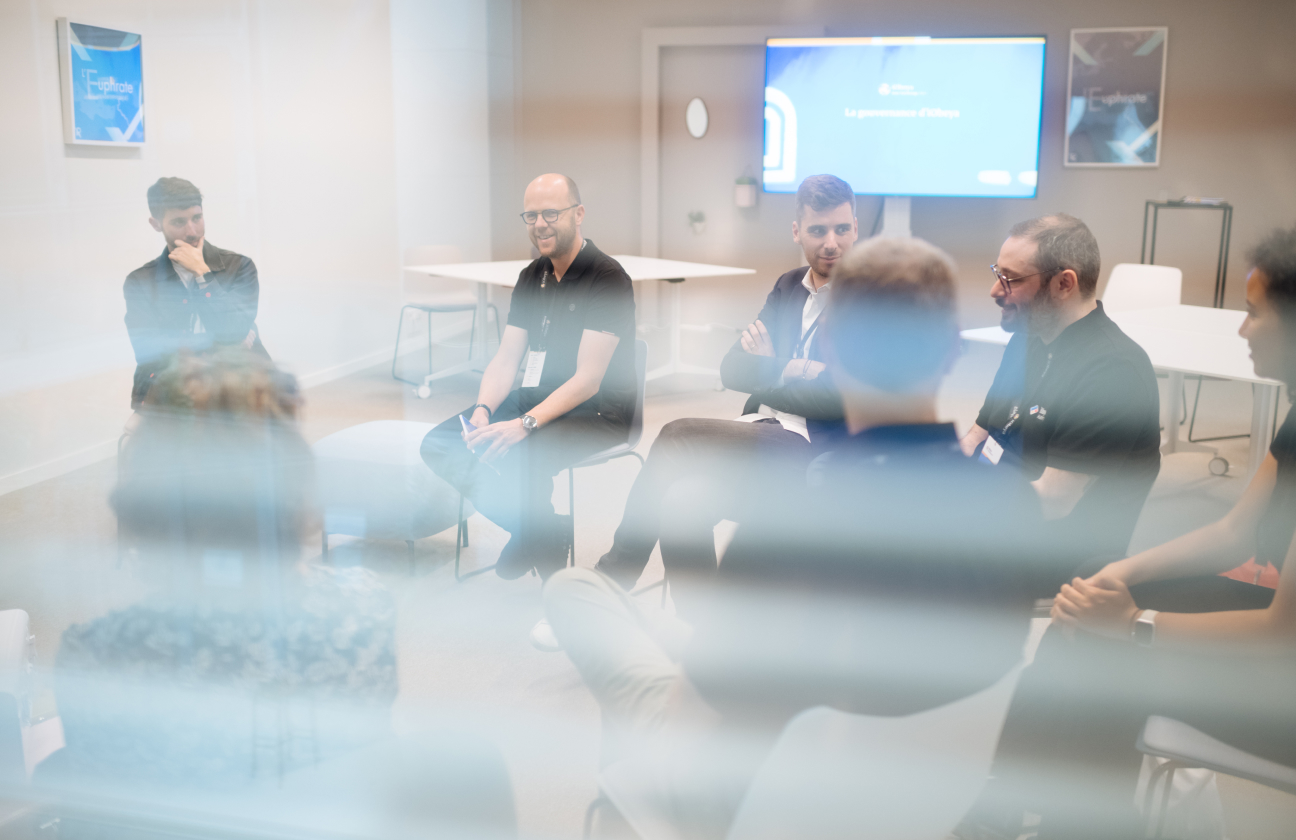Commencer mon aventure iObeya !
Au cœur du Lean Manufacturing se trouve le concept de « Shop Floor Management » (gestion de la production), une approche stratégique axée sur le monitoring en temps réel, la résolution de problèmes et l’amélioration continue pour favoriser l’excellence opérationnelle.
Il se peut que vous ayez déjà numérisé certains éléments de la Méthodologie Lean tel que le 5S, le Kanban ou le Poka Yoke, mais cette transformation a-t-elle été étendue jusqu’à vos lignes de production ? Votre prochaine étape consisterait alors à exploiter les approches numériques d’optimisation des processus jusque dans les ateliers, car la numérisation de l’ensemble du système de production comporte de nombreux avantages.
Cet article explore les avantages de la digitalisation du « Shop floor » (gestion de la production), et surtout comment le faire, en illustrant comment les bons outils digitaux peuvent propulser les entreprises vers une nouvelle ère de productivité, de qualité et de compétitivité.
Les avantages de la numérisation du shop floor management
La digitalisation est devenue une nécessité dans de nombreuse industries, notamment pour maintenir leur compétitivité. Voici quelques-uns des avantages de la numérisation de votre gestion de la production.
Accessibilité des données en temps réel
-
Amélioration de la visibilité
La digitalisation offre une transparence tout au long du processus de production. Vous pouvez surveiller les tendances, analyser les délais et le progrès en temps réel et partager facilement l’état de vos lignes de production. La Cartographie de la chaîne de valeur (Value Stream Mapping) aide également à surveiller l’avancement de l’exécution et les écarts par rapport aux résultats attendus, ce qui vous permet d’identifier et de gérer plus efficacement les goulots d’étranglement.
-
Prise de décisions basées sur les données (Data-Driven decision making)
Avec des outils numériques, vous avez accès à des métriques qui facilitent la prise de décision basée sur les données. Les décideurs peuvent prendre des choix éclairés en se basant sur des informations tirées de données en temps réel, ce qui conduit à des actions plus définitives pour favoriser l’amélioration.
-
Réduction des temps d’arrêt
Limiter au maximum les temps d’arrêt de production dans les usines est l’un des objectifs principaux du Lean manufacturing. En digitalisant la gestion de la production, vous pouvez identifier et traiter les causes profondes des problèmes pour améliorer l’efficacité à long terme et limiter, autant que possible, les arrêts de production.
-
Rationalisation de la communication
La numérisation brise les silos au sein des organisations. Elle connecte les équipes dispersées à l’échelle mondiale et les différents niveaux de l’organisation, favorisant une culture de responsabilité partagée. La communication devient plus efficace car elle se concentre sur ce qui est le plus important et nécessite une attention immédiate.
-
Allocation efficace des ressources
Les outils numériques aident à optimiser l’allocation des ressources. Grâce aux données en temps réel, vous pouvez allouer les ressources là où elles sont le plus nécessaires, favorisant une utilisation efficace de la main-d’œuvre et des machines.
-
Amélioration continue
La numérisation de la gestion de la production s’aligne parfaitement avec le concept Kaizen, d’amélioration continue des processus. En analysant régulièrement les données en temps réel, vous pouvez identifier des domaines à améliorer et mettre en œuvre des changements rapidement.
Dans les configurations traditionnelles du Manufacturing, la collecte et l’analyse des données sont souvent sujettes à des latences, ce qui entraîne des goulots d’étranglement dans la prise de décision. La numérisation de la gestion jusqu’aux lignes de production permet des mises à jour et une visualisation rapides des données. Vous pouvez ainsi facilement escalader, suivre les actions et résoudre les problèmes pour réduire le “lead time” (délai de production et de mise sur le marché). Par ailleurs, en agrégeant des données de sources multiples, vous pouvez identifier efficacement les domaines nécessitant des améliorations. Cela conduit à une communication plus fluide avec des informations constamment mises à jour, impliquant toutes les parties prenantes, favorisant l’alignement organisationnel et la transparence.
Comment numériser la gestion de la production en harmonie avec les principes Lean
Maintenant que nous avons vu les avantages de la numérisation du “Shop floor management”, explorons comment vous pouvez entamer le chemin de cette transformation numérique.
- Identifier les indicateurs clés
Commencez par identifier les indicateurs clés les plus importants pour votre processus de production. Ils peuvent inclure à la fois des indicateurs précurseurs et tardifs (leading and lagging indicators) qui fournissent des informations sur vos opérations.
- Investir dans la bonne technologie
Choisissez une plateforme numérique capable de regrouper et de consolider des données provenant de sources diverses, d’escalader les problèmes ou d’émettre des alertes, et de fournir des informations en temps réel. La technologie devrait être en phase avec vos principes Lean et soutenir vos efforts d’amélioration continue.
- Motiver et former ses employé
Les parties prenantes clées et les dirigeants doivent être activement impliqués dans le processus de numérisation. Leur adhésion est essentielle pour une transition réussie. Impliquer les membres de l’équipe à tous les niveaux de l’organisation, complétée par une formation, contribue à garantir que tout le monde comprend les nouveaux outils numériques et leurs rôles dans le processus.
- Intégration des données
Pour réduire le besoin de saisie manuelle de données et garantir leur précision, intégrez vos systèmes digitaux avec les bases de données et les systèmes existants. Cette intégration simplifie le processus de collecte des données et réduit les risques d’erreurs.
- Surveillance et ajustement
La numérisation n’est pas un projet ponctuel ; c’est un processus continu. Surveillez en permanence vos systèmes numériques, analysez les données et ajustez vos processus en fonction des informations que vous obtenez. Cela suit les cycles Lean PDCA (Planifier-Faire-Vérifier-Agir) ou DMAIC (Définir-Mesurer-Analyser-Améliorer-Contrôler).
Renforcer les pratiques Lean avec les bons outils numériques peut donner à votre gestion de la production, et à votre organisation, l’avantage concurrentiel nécessaire dans l’ère moderne de la fabrication. En digitalisant vos pratiques Lean, vous pouvez exploiter les données en temps réel, améliorer la visibilité, favoriser la prise de décision basée sur les données, réduire les temps d’arrêt, rationaliser la communication, allouer efficacement les ressources et réaliser des améliorations continues. L’avenir du Lean Manufacturing est numérique, et ceux qui s’adaptent prospéreront dans l’ère de l’efficacité et de la compétitivité.
Commencer
mon aventure iObeya !
Hey, let’s start your
iObeya journey!
If there is one thing that has always excited Cyril Daloz during his two decades of donning various roles at large companies, it’s the desire for an organization based on strong human values to succeed at scale. « I wanted to create a global company with a new approach to team leadership and new models of collaboration across an organization, » mentions Daloz. Driven by this passion alongside an ambition to build a global B2B software company, he spent days and nights formulating ideas. But none of them was able to combine the right product fit that matches his vision with a growing market and a strong investor interest. So in 2005, Daloz partnered with a like-minded colleague and created KAP IT, a services company that created innovative, bespoke applications for large Enterprises. Over the next five years, Daloz built a team, became profitable, and invested in the technology building blocks to support the future arrival of the idea that would come from one of his customers.
The Origins of iObeya, the Digital Visual Management software
The breakthrough came in 2011 when PSA Peugeot Citroën, the French automobile manufacturer—now known as PSA Groupe—brought the KAP IT team into a room with whiteboards, posters, post-it notes, and visual indicators covering the walls. « They explained to us that this is an ‘Obeya,’ a place to practice Visual Management which was part of the framework of their lean transformation, » mentions Daloz. To support their lean transformation, PSA Groupe felt it was critical to deploy Obeya rooms throughout their organization. But to do so, they needed to digitize their Visual Management and create virtual Obeya rooms. This meeting changed everything as it gave Daloz the idea he always believed in, giving birth to iObeya.
The idea was a digital solution that allowed multi-site teams to practice their Visual Management while keeping the « human-centric » side and the collective intelligence approach intact.
Based on the Japanese concept of Oobeya, iObeya is an enterprise platform that virtualizes meeting rooms dedicated to all Visual Management practices. The company’s extremely intuitive Digital Visual Management solutions are designed from the ground up for large touch screens that replicate the design and the experience of paper on a wall. iObeya offers a unique, life-like, and immersive user experience, unlocking the constraints of paper for a seamless digital transition. « We are fierce advocates of the value of visual management and see iObeya as a transformative tool as companies embrace Agile and Lean methodologies, » says Daloz. Today, PSA Group has over 2000 iObeya virtual rooms serving nearly 20,000 daily users.

Digitization at its Best
iObeya’s digital tools also complement Microsoft’s Collaborative Workplace offerings by allowing clients to hold any type of meeting–from a post-it based creativity workshop to the Agile daily scrum to project and operations reviews for Lean continuous improvement. Through iObeya, visual management is centralized around people and how team members interact and collaborate.
The user experience is at the forefront of iObeya’s development efforts. Nearly half of the company’s R&D is dedicated to optimizing the user experience, whether that is using large format touch screen displays in a huddle room or simply connecting via personal devices. « Recreating and staying true to the experience of paper on a wall is the biggest challenge in digitizing Visual Management. We did this by examining and re-examining the user experience, whether a team is co-located or distributed across multiple locations, » says Daloz. iObeya has also created innovations such as digital glue, which mimics the real-world experience of stacking post-its and stickers, further accelerating adoption and enabling people to participate even more actively in a stand-up meeting and interact with their project boards and each other.
« We also look ahead of the market to see where Agile and Lean are going, » comments Daloz. For example, while Agile is traditionally a software methodology, iObeya sees Agile being used in HR, Sales, Marketing, Legal, and across the organization. iObeya observes the same with Lean transformation, which started in manufacturing but has now spread to all types of companies and organizations. Now, as companies are looking to scale Agile, iObeya sees Lean and Agile integrating to become part of a Lean Enterprise. This is one reason why they are partnering with Scaled Agile, Inc. in support of the Scaled Agile Framework, or SAFe.
Visual Agile Framework for Global Team Collaboration
The user experience is at the forefront of iObeya’s development efforts. Nearly half of the company’s R&D is dedicated to optimizing the user experience, whether that is using large format touch screen displays in a huddle room or simply connecting via personal devices. « Recreating and staying true to the experience of paper on a wall is the biggest challenge in digitizing Visual Management. We did this by examining and re-examining the user experience, whether a team is co-located or distributed across multiple locations, » says Daloz. iObeya has also created innovations such as digital glue, which mimics the real-world experience of stacking post-its and stickers, further accelerating adoption and enabling people to participate even more actively in a stand-up meeting and interact with their project boards and each other.
« We also look ahead of the market to see where Agile and Lean are going, » comments Daloz. For example, while Agile is traditionally a software methodology, iObeya sees Agile being used in HR, Sales, Marketing, Legal, and across the organization. iObeya observes the same with Lean transformation, which started in manufacturing but has now spread to all types of companies and organizations. Now, as companies are looking to scale Agile, iObeya sees Lean and Agile integrating to become part of a Lean Enterprise. This is one reason why they are partnering with Scaled Agile, Inc. in support of the Scaled Agile Framework, or SAFe ®.
Integrating the Customer into the Agile Cycle
iObeya believes that going digital enables visual management methodologies at scale, matching the systematic approach of enterprise-wide transformational initiatives. It improves team efficiency and impacts the overall performance of the organization. As such, the company is accelerating the adoption of visual management by pushing the boundaries of paper in harmony with the people-centered principles of Lean and Agile. The biggest differentiator for them is that all these capabilities are delivered on an enterprise platform that addresses the Visual Management requirements of all major use cases and practices such as Agile@Scale, Lean Enterprise, Industry 4.0, and the Digital Workplace. This way, they facilitate management transformations of companies by providing a methodological, digital, and cultural approach.
iObeya understands the needs of the customer and the context in which they operate. During the design phase, the company exchanges ideas on the types of solutions that they are imagining. At each Sprint, feedback is collected on each intermediate version that iObeya produces. The company provides continuous access to its pre-release platforms for many of the key customers. Each solution area (Lean, Agile, Industry 4.0, and Digital Workplace) has its own Voice of the Customer Focus Group. Expert users make a one-year commitment to be integrated into the development processes and meet with the company’s team every quarter to review the Program Increments such that it can be shared in iObeya’s roadmap. « We also want our customers to share information amongst themselves, » says Daloz. iObeya has a user club that ensures regular exchanges on the product, the services, and the vision. Customers can share best practices and learn from each other. The company also hosts an annual user event to connect customers and provide more opportunities to collaborate. « Ultimately, the goal for iObeya is customer success, » Daloz mentions. And achieving it is much easier when real customers are included throughout the product development cycle. « The bonus is that we have great sponsors when we launch new iObeya features into the market, » he says.
Building an Agile Future
Designed on the principles of Lean and Agile, iObeya keeps the digital tools and interactions as close as possible to those in the real world. « But we extend iObeya beyond the walls, beyond the constraints of space, of distance. Each organization can deploy visual management to their geographically distributed teams while staying true to their existing, often well-established, management rituals, » states Daloz. As part of Industry 4.0, iObeya is contributing to the transformation of operational excellence in the factory. The company digitizes the entire operational performance management system, from the shop floor to the industrial department. For instance, at the pharmaceutical firm Sanofi, iObeya consolidated up to 6 levels of KPIs and escalated improvement actions.
Looking forward, iObeya sees an opportunity to use its strength in visualization to become a visual platform that integrates with a broad range of systems and software packages. This year, iObeya released its fully-synchronized Jira integration that was well received by customers. Using its robust API and SDK, iObeya plans to extend this to other types of back end systems, providing visibility and a single place for teams to communicate and collaborate about the business. « We want to position iObeya as a universal visual framework to manage the organization, projects, and production as a whole, » concludes Daloz.
If you would like to accelerate your Lean or Agile transformation with iObeya, contact our experts today.








